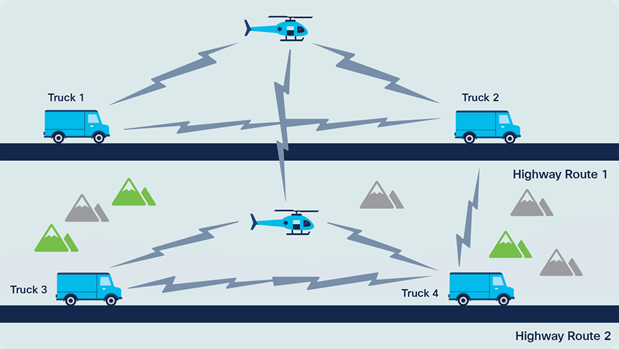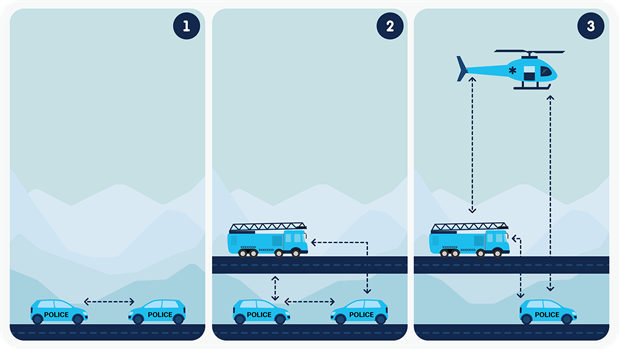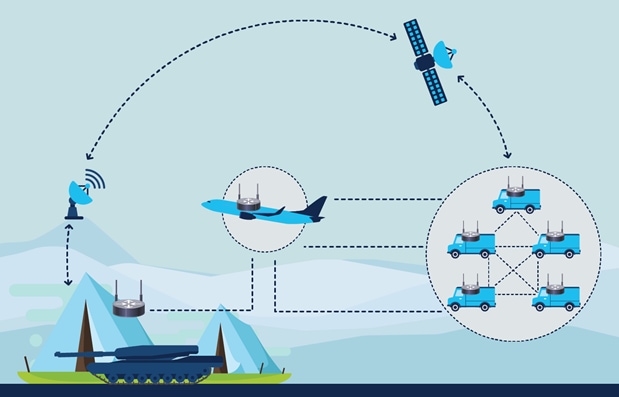Radio Aware Routing At-a-Glance
Available Languages
Bias-Free Language
The documentation set for this product strives to use bias-free language. For the purposes of this documentation set, bias-free is defined as language that does not imply discrimination based on age, disability, gender, racial identity, ethnic identity, sexual orientation, socioeconomic status, and intersectionality. Exceptions may be present in the documentation due to language that is hardcoded in the user interfaces of the product software, language used based on RFP documentation, or language that is used by a referenced third-party product. Learn more about how Cisco is using Inclusive Language.
Relief workers, soldiers, public safety personnel, and others need the right information in the right place at the right time, wherever they are located. Mobile ad hoc networks (MANETs) are emerging to address these needs. Today there is a choice of two different Internet Engineering Task Force (IETF)-defined protocols. Request for Comments (RFC) 5578 defines a Point-to-Point Protocol (PPP) over Ethernet (PPPoE) extension using a credit based control flow and link metric adjustment mechanism for integrating IP routers and mobile radios in ad hoc networks, enabling faster convergence, more efficient route selection, and better performance for delay-sensitive traffic for point-to-point radio network topologies. RFC 8175 defines Dynamic Link Exchange Protocol (DLEP), a control protocol between a router and a DLEP-enabled radio modem operating in a mesh radio topology.
Consider relief workers in the aftermath of a natural disaster, where the network infrastructure may be impaired or destroyed; soldiers in the field, deployed beyond the reach of a fixed infrastructure; police, fire, or emergency medical services responding to a complex, multiagency emergency scene in which traffic has overloaded available resources. For these “disadvantaged” users the need to communicate is acute; sharing the right information at the right time can be a matter of life or death. These scenarios require direct wireless IP networking between local peers that will work even when fixed networks and central services are unreachable.
Looking at a real-world example

Physical mesh topography
The network in Figure 1 is a voice, video, and data network between moving vehicles that consists of both ground and air vehicles. Hence the network is mobile, and it is a peer-to-peer mesh that changes as topographical obstructions are encountered. It is put together “on the fly.” This is where we get the term mobile ad hoc network or MANET for short.
In the scenario shown in the figure, all four trucks always have connectivity with the helicopters that are flying over the same road. The two helicopters always have line of sight and will always have a connection with each other. The trucks may even be able to connect to the other helicopter or a truck on the opposite road when conditions are favorable.
Here we see that the path between trucks 1 and 3 is completely blocked. The path between trucks 2 and 4 is about to be blocked.
Our existing routing protocols such as Open Shortest Path First version 3 (OSPFv3) and Enhanced Interior Gateway Routing Protocol (EIGRP) need to adjust their path metrics very quickly to maintain a cohesive operational network. The routing protocols also need a way to get that information from the radios, which requires a radio-to-router protocol that is delivered by Cisco® Radio Aware Routing in the form of the two open protocols DLEP and PPPoE Extensions for Credit Flow and Link Metrics.
MANET characteristics and benefits
MANETs are emerging as a means for delivering the benefits of IP networking to users operating beyond the reach of a fixed network. In MANETs, mobile nodes associate on an extemporaneous or ad hoc basis (refer to Figures 1, 2, and 3). Ad hoc networks have numerous distinguishing characteristics and benefits when compared to conventional networking solutions:
● Self-forming: Nodes that come within radio range of each other can establish a network association without any preconfiguration or manual intervention.
● Self-healing: Nodes can join or leave rapidly without affecting the operation of the remaining nodes.
● No infrastructure: In a MANET, mobile nodes form their own network and essentially become their own infrastructure.
● Peer to peer: Traditional networks typically support end systems operating in client-server mode. In a MANET, mobile nodes can communicate and exchange information without prior arrangement and without reliance on centralized resources.
● Predominantly wireless: Historically, networks have been mostly wired and enhanced or extended through wireless access. The MANET environment is essentially wireless but can be extended to support wired resources.
● Highly dynamic: Mobile nodes are in continuous motion and ad hoc networking topologies are constantly changing.
● Key enabler for new applications, such as vehicle-to-vehicle networking, intelligent transportation systems, sensor networking, telemetry monitoring, and more.
Collectively, these characteristics enable MANETs to deliver timely information to a new and underserved class of users. Ad hoc networking solutions can be applied to virtually any scenario that involves a cadre of highly mobile users or platforms (which may include stationary devices as well), a strong need to share IP-based information, and an environment in which fixed infrastructure is impractical, impaired, or impossible.

Ad hoc networks form as nodes come within range

Radio aware routing for military applications
Taking advantage of Cisco Radio Aware Routing for MANET
Effective networking in a MANET environment requires mechanisms by which routers and radios can interoperate efficiently, without impacting the operation of the radio network; radios can report status to routers for each link and each neighbor; routers can more readily recognize topology changes; and routers can use radio link information to optimize routing decisions. To address these needs, the Cisco RFC 5578 and RFC 8175 implementation incorporates the following features:
● Quality of Service (QoS) for radio links: Minimizing the need for queuing in the radio.
● Neighbor up/down signaling: Cisco routers can use session establishment or termination signals from the radio to update routing topologies.
● Link quality metrics reporting: These protocols enable a radio to report (or a router to query) link quality metric information. Cisco routers have been enhanced to allow the OSPFv3 and EIGRP routing protocols to factor RF link quality metrics into route cost calculations.
MANETs are emerging to deliver IP-based voice, video, and data to users who may be operating beyond the reach of traditional fixed network infrastructure.
RFC 5578 and RFC 8175 provide an effective, cross-layer mechanism for communicating radio network status to IP routers—RFC 5578 primarily for point-to-point topologies and RFC 8175 primarily for mesh topologies.
Today Cisco IOS® XE delivers Radio Aware Routing beginning in Cisco IOS XE Release 17.8.1 under the Network Advantage license for the Cisco ESR6300 Embedded Series Routers.
● View Cisco Radio Aware Routing White Paper
● Read Cisco Radio Aware Routing blog
● Review Cisco Embedded Service 6300 Series Software Configuration Guide